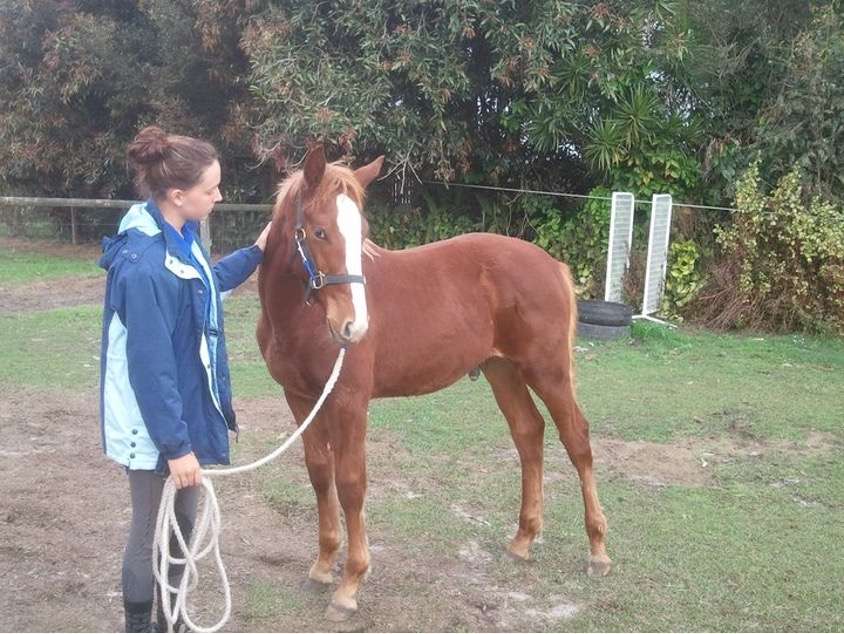The value of training during handling (leading, feeding, brushing…) a horse and ground work before riding is often underestimated. Whether you are aware of it or not, every minute you spend with your horse you are teaching and training. The horse does not differentiate between “we are in the arena now so this must be training” and “we are in the paddock or at the stable now, so this is where I can do what I want”.
Training starts with the first eye contact when you meet your horse in the paddock and it ends with the release into the paddock after work – whether your horse continues to improve, whether it keeps learning and becoming an even better equine partner or whether it develops unwanted behavior is your choice. And as long as you are not aware of what you teach and show by handling your horse chances are situations will become worse rather than better.
Making mistakes as such is not a bad thing, it is how we (and our horses!) learn, so we should appreciate and work on them.
BE AWARE OF HOW YOU LEAD YOUR HORSE
Many problems can be created or solved already by the way you lead your horse.
The horse should not push or run into you, step on your feet or run into your heels. Old school teaching the leading position to be always so that the horse’s head is in shoulder height of the leader can lead to problems when e.g. you go through a narrow path where space does not allow enough room to walk next to each other. Besides, some horses prefer to walk behind the leader and in my eyes that’s perfectly alright as long as they don’t push.
You are leading the way not the horse, don’t let yourself being pulled and dragged where the horse wants to go. It is important that the horse pays attention to you, where you are and where you want to go – this is especially important in case the horse gets a freight to ensure it won’t jump into you.
Do not hold the lead rope close to the horse’s head but about 1-1.5m away from the halter ring and allow it to hang loose. If you hold the rope to short and tight, your position will be too close to the horse and really invite it to come too close and push. Pressure creates counter-pressure and horses instinctively tend lean into pressure. Often horses will be much calmer when not every tiny movement is controlled by the leader’s hand!
BEING INATTENTIVE
This is a common mistake I fall victim to myself very often But shouldn’t we be aware of our body language and the horse’s movements at all times just as much as we expect the horse to “behave” and pay us attention at all times – especially with young horses and those undergoing re-training where good behavior is not fully established?
Especially when meeting with friends and going quickly to the paddock to fetch, brush, saddle the horse it happens that the mind is focused more on the chit chat than on the animal. And when we are inattentive mistakes sneak in. We don’t realize the horse is a bit more pushy than it should be and whilst keeping up the chat with the friend we instinctively step out of the way and we pull on the lead rather than using our training methods when it stops to have a bite of the inviting green grass on the way to the stable .
BEING INCONSEQUENT
Reacting to the same behavior the same each and every time means predictability, reliability and fairness to your horse.
You simply can’t afford to allow one thing one day when your mind is focused on something else and then punish your horse harshly for the same behavior tomorrow – your horse won’t understand but quickly lose trust in you and won’t accept you as reliable leader.
Establish rules and stick to them, on a good day as well as on days when might feel stressed, upset or tired. Don’t accept your horse rubbing its forehead on your shoulder as a cute expression of “I love you” whilst pushing it angrily away on another day.
BEING PATIENT
Lack of patience unfortunately often turns into spontaneous, even violent action – “what, the horse doesn’t want to go there? Nothing a whip or spurs or a deftly pull on the lead rope can’t fix” Most of the times the horse will remember this situation as being stressful on top of the object it might have been fearful of in the first place and chances are, next time if won’t even go close to it.
Most issues are resolved much easier – and faster in the end too – by working patiently with the horse to overcome an issue and praise each small step into the right direction.
BEING IN A HURRY
You know today it has to be quick, you just arrived and know you will have to leave the stable in half an hour, but the horse needs exercise, so hop on for a quick ride..
DON’T DO IT !!! It is predictably not going to be a good session!
Being in a hurry leads to stress, lack of concentration, wrong body language, lacking patience and it is much easier to lose your temper. What about taking your horse for a short walk instead, sit somewhere and have it graze, give it a good brush – it will help you and your horse relax and can turn into a valuable bonding time.
WARMING UP
Doing it right you spend an appropriate amount of time to properly warm up your horse in walk and trot, bending and stretching before asking strenuous exercise. But what about yourself? Getting on the horse with stiff hips and legs and tense shoulders won’t get you far. How do you expect to stay in soft and flexible contact with legs, seat and hands if you are stiff as a broomstick? Spending 10-15 minutes to warm up and stretch your muscles before riding might bear surprising results for you in the following ride Check the facebook group “Equine Sports – Exercises for Horses and Riders” if you are after ideas
YOU DON’T USE A MOUNTING BLOCK
Pulling yourself up on the horse means tremendous forces on the horse’s most vulnerable spine. Especially if like most of us you always mount from the same side of the horse. It does not matter whether you use a specially designed mounting block, an old milk crate, a tree stump or a chair – it just should be high enough so you can easily reach the stirrup and get into the saddle quick (not with a big blob though!!! But sitting down softly) without pulling on the saddle, mane, reins etc.
Don’t worry about being ridiculed using a mounting block or –aid ! Your horse’s health and wellbeing should be more important to you than the opinion of others who obviously don’t care.


0 Comments